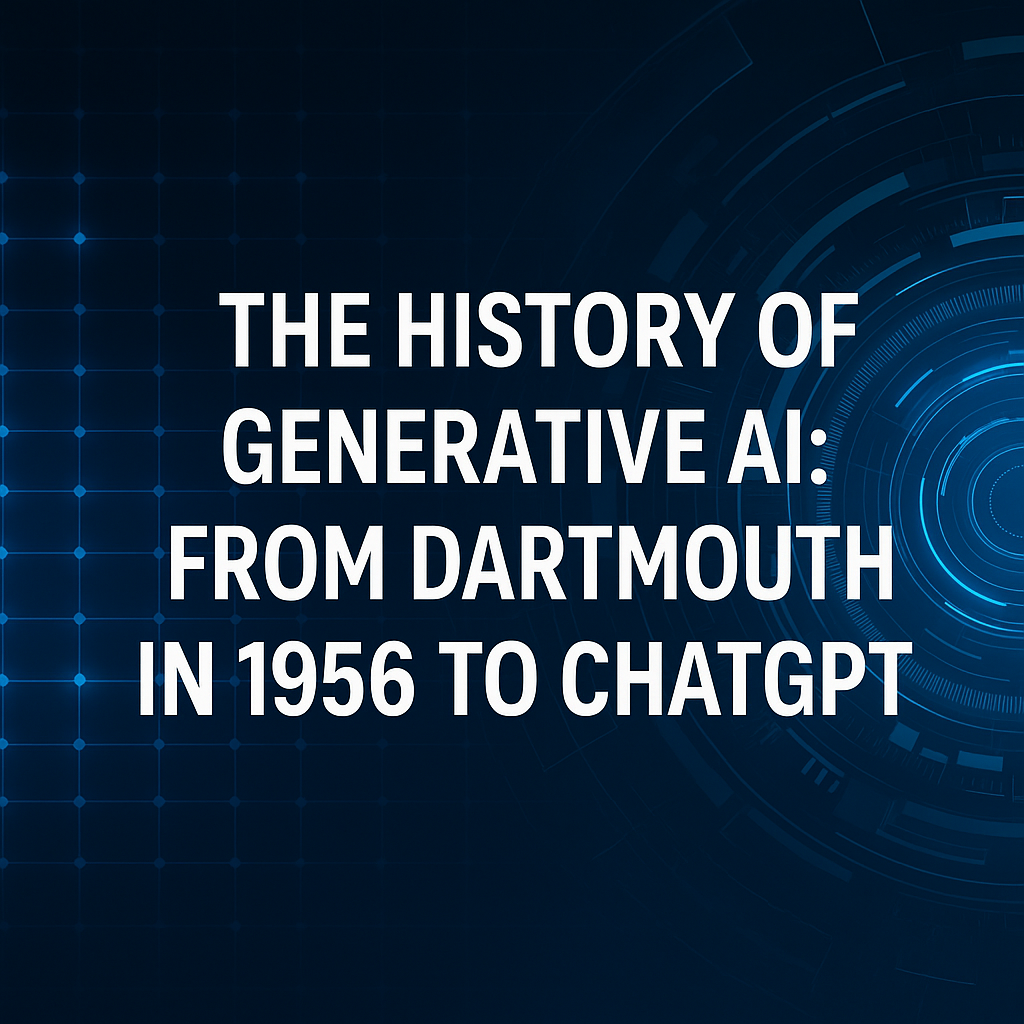In November 2022, the release of ChatGPT ignited a global conversation. Seemingly overnight, artificial intelligence evolved from a niche research topic into a transformative force with mainstream appeal. But this was no sudden miracle — rather, it was the result of over half a century of relentless exploration, debate, and innovation.
To truly understand the rise of generative AI (GAI), we must return to the summer of 1956, to a small college in New Hampshire.
A Summer That Changed Everything: The 1956 Dartmouth Conference
In the quiet town of Hanover, a group of visionaries gathered at Dartmouth College. Led by John McCarthy, and joined by Marvin Minsky, Nathaniel Rochester, and Claude Shannon, this meeting would become known as the Dartmouth Conference, now recognized as the birthplace of artificial intelligence.
Their mission? Bold and unprecedented:
To explore whether machines could simulate intelligence, not just calculate numbers or follow scripts.
In their research proposal, McCarthy and his colleagues outlined several core questions:
- Can machines learn from experience?
- Can they use language?
- Can they form abstract concepts?
- Could a machine improve itself?
- And most daringly: Can machines solve problems once thought to require human intelligence?
Though only around ten researchers participated, their two-month discussion laid the intellectual foundation for what would become the entire field of AI. It was here that the term “Artificial Intelligence” was officially coined.
The Long March: Classical AI and Machine Learning
The next few decades were filled with both excitement and frustration. AI research moved slowly, constrained by limited computing power and small datasets. Still, important tools were created, including decision trees, perceptrons, support vector machines (SVMs), and random forests.
These algorithms became the backbone of traditional machine learning, widely used in fields like finance, healthcare, and marketing. Yet the dream of human-like intelligence remained elusive.
The Deep Learning Breakthrough: Laying the Groundwork
In the 1980s and 1990s, the seeds of modern AI were planted. Researchers developed key neural network architectures:
- Convolutional Neural Networks (CNNs) for image recognition
- Recurrent Neural Networks (RNNs) for sequences and time-series data
- Long Short-Term Memory (LSTM) networks for retaining information across time steps
However, these models lacked the computing resources and data to shine — their promise remained largely theoretical.
A Turning Point: ImageNet and AlexNet (2012)
In 2012, a deep convolutional neural network called AlexNet shocked the AI community by winning the prestigious ImageNet competition.
Before AlexNet, the best-performing models had a Top-5 error rate of around 25.7%. AlexNet slashed that to 15.3% — a dramatic improvement that no one had anticipated.
This wasn’t just an incremental gain; it was a breakthrough. For the first time, a neural network had convincingly outperformed traditional hand-crafted feature approaches. It marked the beginning of the deep learning era.
Powered by GPUs, equipped with novel techniques like ReLU activations, dropout, and data augmentation, AlexNet showed that deep architectures could finally achieve practical results — given enough data and compute.
Generative AI Is Born: The Arrival of GANs (2014)
Until 2014, AI models were mostly descriptive — designed to analyze or classify existing data. Then came Generative Adversarial Networks (GANs), introduced by Ian Goodfellow and colleagues.
GANs worked differently: they learned the underlying data distribution to generate entirely new data that looked eerily realistic. This marked the true beginning of generative AI.
With GANs, machines could now create:
- Human faces that didn’t exist
- Synthesized artworks
- Realistic simulations of natural phenomena
This wasn’t just a technical innovation — it was a philosophical shift. AI was no longer just analyzing the world. It was imagining new ones.
The Language Revolution: From Attention to Transformers
While GANs revolutionized image generation, a parallel revolution was brewing in language.
The Transformer architecture, introduced in 2017, replaced older sequential models with a system that could understand context holistically through self-attention mechanisms. This paved the way for groundbreaking models like:
- BERT (2018) – for understanding text meaning
- GPT (2018–2022) – for generating human-like language
By the time GPT-3 launched in 2020, it could write essays, code, poems — even simulate conversations. The boundary between machine and human communication began to blur.
ChatGPT: AI Meets the World (2022–)
Then came ChatGPT, released by OpenAI in November 2022.
Trained on a vast corpus of text, fine-tuned for dialogue, and deployed with a user-friendly interface, ChatGPT became the moment when generative AI entered public consciousness.
Millions experimented with it — writing scripts, solving math problems, planning trips, or simply chatting. For many, it was their first direct encounter with an intelligent machine.
Its impact was immediate and far-reaching:
- In education, it changed how students write and research.
- In business, it began reshaping customer service, content creation, and automation.
- In ethics and policy, it raised questions about bias, misuse, and regulation.
Looking Ahead: The Generative AI Frontier
Generative AI continues to evolve, with new techniques like self-supervised learning, multimodal models, and AI agents that can take action in digital environments.
From synthetic data generation to drug discovery, from creative art to autonomous systems, the implications are enormous.
Yet the questions first asked at Dartmouth still remain:
- Can machines truly understand?
- Should they be allowed to decide?
- And how do we ensure they benefit all of humanity?
Final Thoughts
The rise of generative AI is not just a story of models and data — it’s a story of human imagination. From a small meeting room at Dartmouth College to millions of users on ChatGPT, it reflects our desire to understand, replicate, and now create intelligence.
As we step into the next phase of AI, one thing is clear:
We are not merely building smarter machines — we are redefining what intelligence means.


Leave a Reply